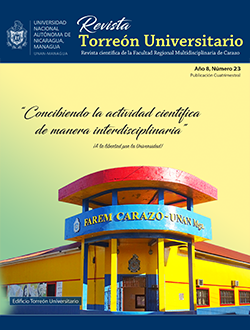Identification and quantification of pesticide residues in vegetables of high consumption commercialized in markets and supermarkets in Managua
DOI:
https://doi.org/10.5377/torreon.v8i23.9532Keywords:
codex alimentarius, maximum residues limits, pesticides, plant matrixAbstract
The use of pesticides for pest control is a common practice in agricultural production systems of Nicaragua. In this study 21 pesticides (7 organophosphorus insecticides, 1 organochlorine insecticide, 3 pyrethroid insecticides, 7 herbicides and 3 fungicides) were studied and determined in samples of tomatoes, peppers, lettuce and cabbage collected in 2 popular markets and 2 supermarkets of Managua. The analysis reflects that 55,0% of the samples contain pesticides, managing to identify residues of chlorpyrifos, mocap, cypermethrin, chlorothalonil, imazalil, diazinon, deltamethrin, simazine and 2,4-D, in concentrations between 0,005 mg/kg up to 5,3 mg/kg. 20,0% of the samples contain residual variables that exceed the values established in the Codex Alimentarius in the matrices lettuce (diazinon), cabbage (chlorpyrifos and diazinon), tomato (mocap and deltamethrin).
Downloads
1554
PDF 257
HTML (Español (España)) 976
HTML 185
References
CAC. (2011). CAC (Codex Alimentarius Committee). Límites máximos de residuos de plaguicidas en alimentos y piensos. Obtenido de http: //www.codexalimentarius.net/pestres/data/commodities/details.html?id=240.
Cuenta Reto del Milenio Nicaragua. (Mayo de 2007). Lineamientos y Procedimientos para el Manejo de Plagas y Enfermedades en Agricultura.
FAO. (2006). Código Internacional de conducta para la distribución y utilización de plaguicidas. ROMA: ORGANIZACIÓN DE LAS NACIONES UNIDAS PARA LA AGRICULTURA Y LA ALIMENTACIÓN.
FAO. (2008). Food and Agriculture Organization of the the United Nations. Obtenido de El cambio climático, las plagas y las enfermedades transfronterizas: http://www.fao.org/tempref/docrep/fao/010/i0142s/i0142s06.pdf
Farfán, F. (2011). Las buenas prácticas agrícolas en la caficultura. Sistemas de produccion de café en Colombia. Obtenido de https://www.cenicafe.org/es/documents/buenasPracticasCapitulo12.pdf
GEF-REPCar, P. (2009). Monitoreo del escurrimiento de plaguicidas al caribe de Nicaragua. Managua.
Latimer, G. (2012). Official Methods of Analysis of AOAC International.
NTON-17002-02. (Diciembre de 2001). Norma de procedimiento para el muestreo de productos vegetales. Norma Técnica Obligatoria Nicarguense. Managua, Nicaragua: La Gaceta.
Pérez, M., Navarro, H., & Miranda, E. (2013). Residuos de plaguicidas en Hortalizas: Problemática y riesgo en México. Revista Internacional de Contaminacion Ambiental, 45-64.
Salgado, T. (1988). Determinación de residuos de plaguicidas en alimentos de consumo interno. Cortés: Programa manejo de plaguicidas.
Servicio fitosanitario del estado. (2013). Informe de los residuos de plaguicidas detectados en vegetales . San José.
Solano, E. (2008). Monitoreo de plaguicidas en tomate para consumo en fresco comercializado en la ciudad de Guatemala. Ciudad de Guatemala: Universidad de San Carlos de Guatemala - Dirección General de Investigación.
UNIVERSIDAD NACIONAL DE COSTA RICA. (2019). Manual de plaguicidas de centroamérica. Obtenido de http://www.plaguicidasdecentroamerica.una.ac.cr/index.php/base-de-datos-menu/124-cipermetrina
UNODC. (2012). Oficina de las Naciones Unidas contra la Droga y el Delito. Glosario de términos sobre garantía de calidad y buenas prácticas de laboratorio. Nueva York.
Van der Hoff, G. R., & Van Zoonen, P. (1999). Trace analysis of pesticides by gas chromatography. Journal of Chromatography, 301-322.
Downloads
Published
How to Cite
Issue
Section
License
Los autores que publican en esta revista están de acuerdo con los siguientes términos.
- El autor o los autores de los artículos, ensayos o investigaciones conceden a la Universidad Nacional Autónoma de Nicaragua, Managua (UNAN-Managua) los derechos de edición (copyright) del trabajo enviado, por consiguiente la Universidad cuenta con el derecho exclusivo para publicar el artículo durante el periodo completo de los derechos de autor.
- Estos derechos de autor/ autores autorizan a la Revista Torreón Universitario y a la Universidad editar y divulgar/publicar el artículo en dicha Revista, incluyendo reproducción impresa y electrónica, el almacenamiento, recuperación y cualquier otro tipo de publicación, y fuentes de información secundaria como servicios de resúmenes y bases de datos, así mismo la facultan a proteger el artículo contra el uso no autorizado para su difusión por medios impresos o electrónicos (PDF, HTML, EPUB, XML u otros).
Licencia para el uso del contenido
La revista hace uso de la Licencia Creative Commons Atribución-NoComercial-SinDerivar 4.0 Internacional.
Bajo esta declaración:

Este revista está sujeta a una licencia de Creative Commons Reconocimiento-NoComercial-SinObraDerivada 4.0 Internacional. Puede ser copiada, distribuida y transmitida públicamente siempre y cuando se cite al autor y la fuente (Revista Torreón Universitario), no debe modificarse ni utilizarse con ningún fin comercial. La licencia completa se puede consultar en http://creativecommons.org/licenses/by-nc-nd/4.0/.



